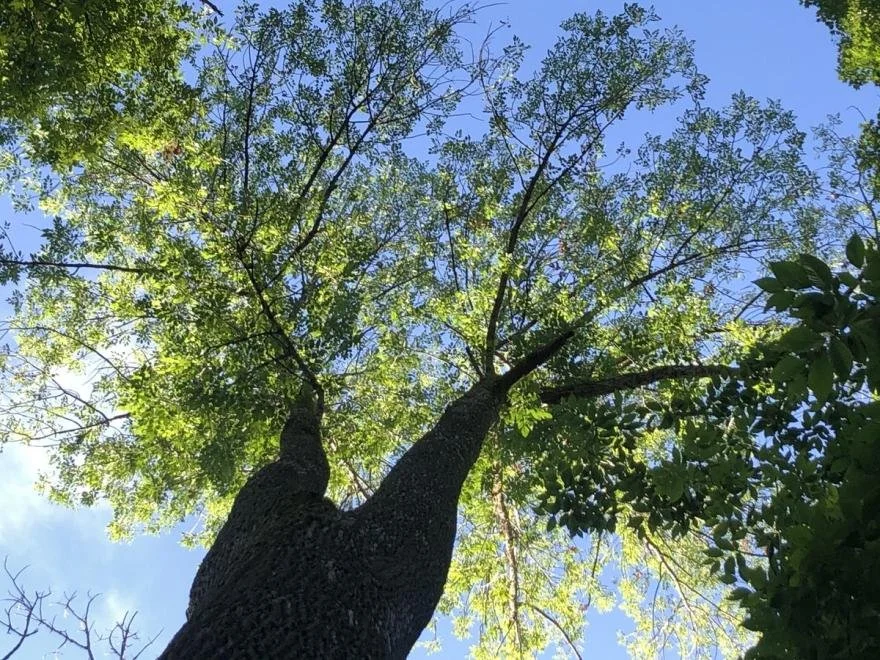Emerald ash borer creeps closer to Blue Hill Peninsula
Only 1 percent of ash trees will survive the invasion, scientists say
The few ash trees that survive could be the key to repopulating. Photo courtesy of the USDA Forest Service.
By Steele Hays
The emerald ash borer, a small, shiny green beetle that has killed hundreds of millions of ash trees and is considered the most destructive and costly forest pest ever to reach North America, is now infesting trees in Bar Harbor–less than 20 miles as the crow flies from Blue Hill. The beetle outbreak in Bar Harbor was discovered in April by a local professional arborist.
The beetles, which are native to China, were first discovered in the U.S. in 2002, when they began killing trees in Michigan. Since then, they have spread to more than 30 states. The outbreak reached Maine in 2018, when the beetles were found in both Aroostook and York Counties. The Maine Forest Service says that “less than one percent of ash trees are expected to survive the [beetle’s] invasion.”
Maine officials have tried to slow the spread by imposing a quarantine on the movement of firewood, ash trees and ash lumber with bark from the counties with known infestations to non-invested areas. After the Bar Harbor outbreak, they imposed a quarantine on any firewood being transported from Mount Desert Island to any other location in Maine. The beetles can fly short distances, so they can slowly expand their range by a half mile per year, but the greatest threat is from infected ash wood being carried by humans.
“It’s an imminent threat. It's only a matter of time before it’s here,” said Phil Norris, Blue Hill’s tree warden. “I’ve been talking to tree wardens in southern Maine and it’s taking out every ash tree in many of those towns.”
Ash trees make up about 3 to 4 percent of the forest canopy in Maine, according to Dr. John Daigle, Professor of Forest Recreation Management at the University of Maine. But in some local areas, ash can be the most common tree species. Daigle spoke Sept. 20 at a workshop on the EAB at the Common Ground Fair in Unity.
Blue Hill has 71 ash trees in the downtown area based on a survey done last year, Norris said.
The beetle poses an especially critical threat to native American populations in Maine whose basketmakers rely on brown ash to make ash splint for baskets. The Maine Forest Service encourages people to report the ash borer, which can easily be mistaken for the harmless tiger beetle. If it is slim with small eyes and small antennae, it could be an ash borer. If it has big eyes, long antennae and a pinched “waist,” it is a tiger beetle and can be left alone.
The Maine Forest Service wants people to know the difference between the harmless tiger beetle (left), and the invasive ash borer. Photo courtesy of the Maine Forest Service.
There are two methods for combatting the beetles. One is to inject a pesticide every three inches around the circumference of ash trees. That will kill any beetles in that tree.
At a cost of approximately $3 per injection, the pesticide treatment can help save a limited number of high-value trees, but it is not a practical solution for saving entire stands of ash trees, according to Daigle. Another method is to release small, stingless wasps from China that prey on the beetles. Foresters are using both methods in Maine.
Norris said Bartlett’s Tree Service is beginning to offer pesticide treatments for ash trees on the Blue Hill Peninsula and recently opened a location in Brooksville to serve the area. Any residents interested in treatment for their ash trees may contact Norris at treewarden@bluehillme.gov.
Foresters and scientists hope to preserve clusters of ash trees by combinations of the two treatments so that in time, the trees can repopulate after the infestations have peaked.
The Yale School of the Environment published an article in 2024 on the efforts to save the one percent of trees that, for some reason, are resistant to the beetles.
“One day, scientists hope, borer-resistant trees will provide seeds to replace some of the millions of ash that have been lost,” the article said.
The Maine Forestry Commission has a “dashboard” on its website providing information on the threat and a map showing infested areas and tracking the spread.



